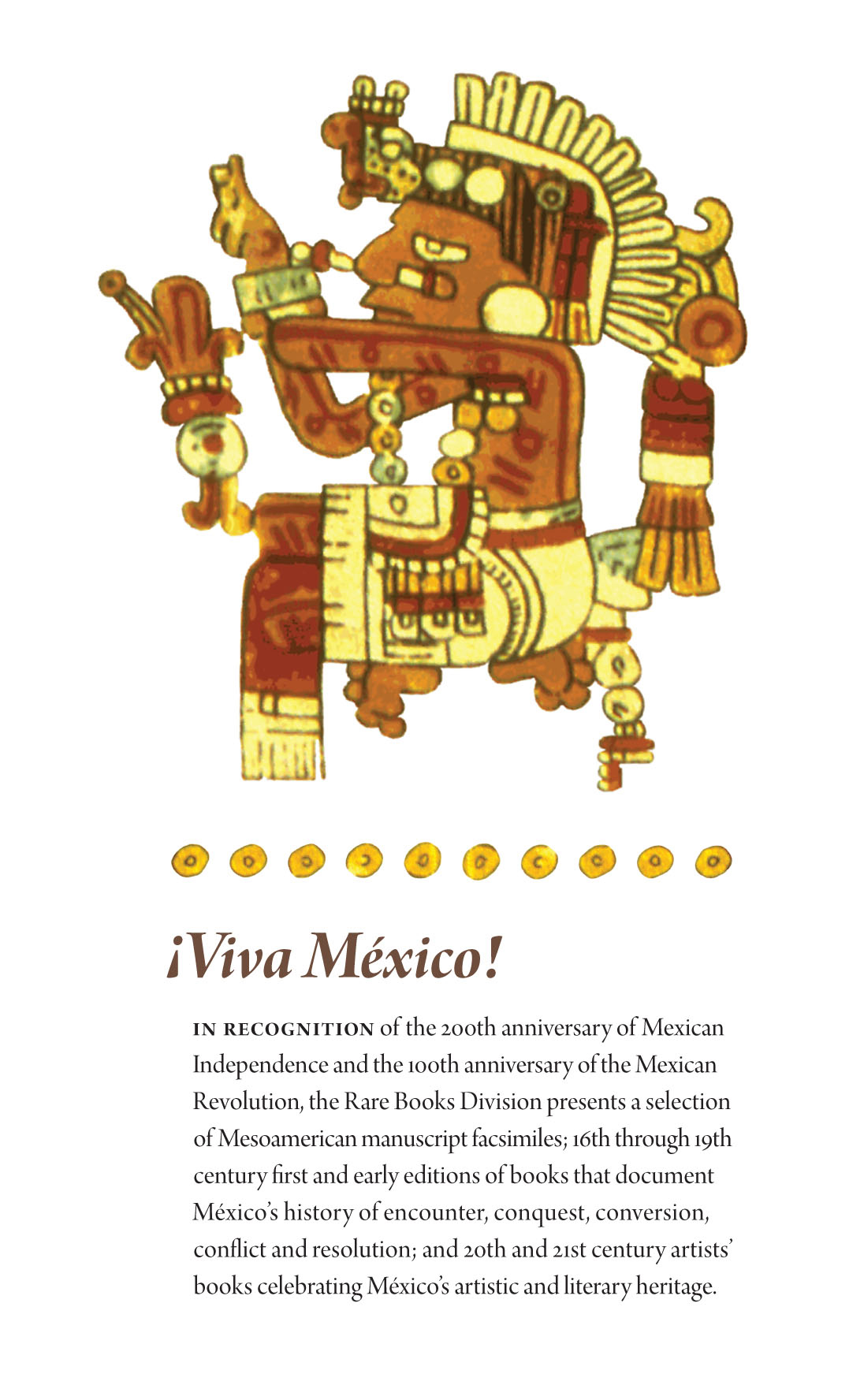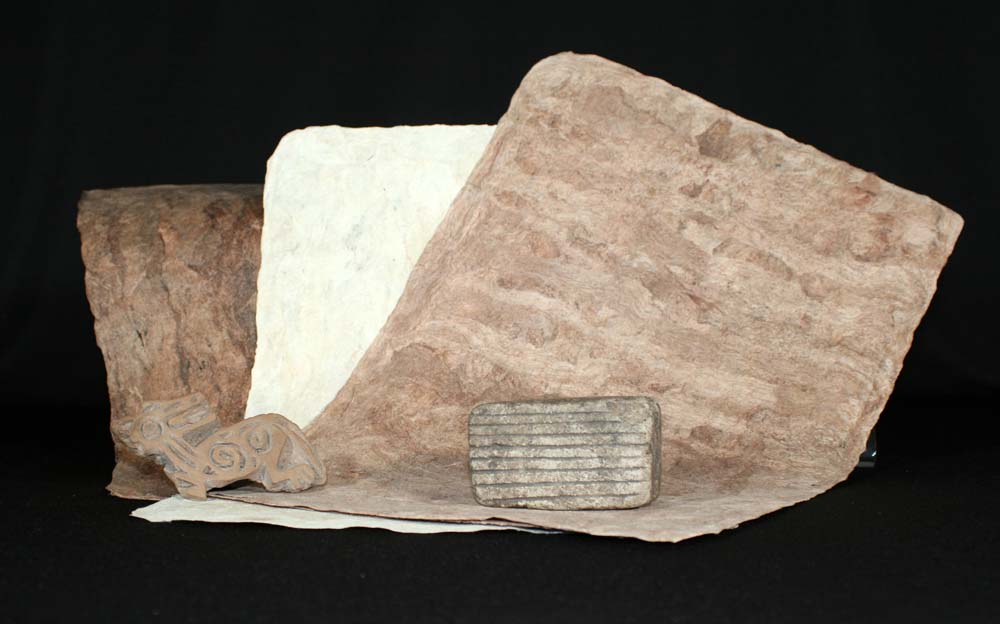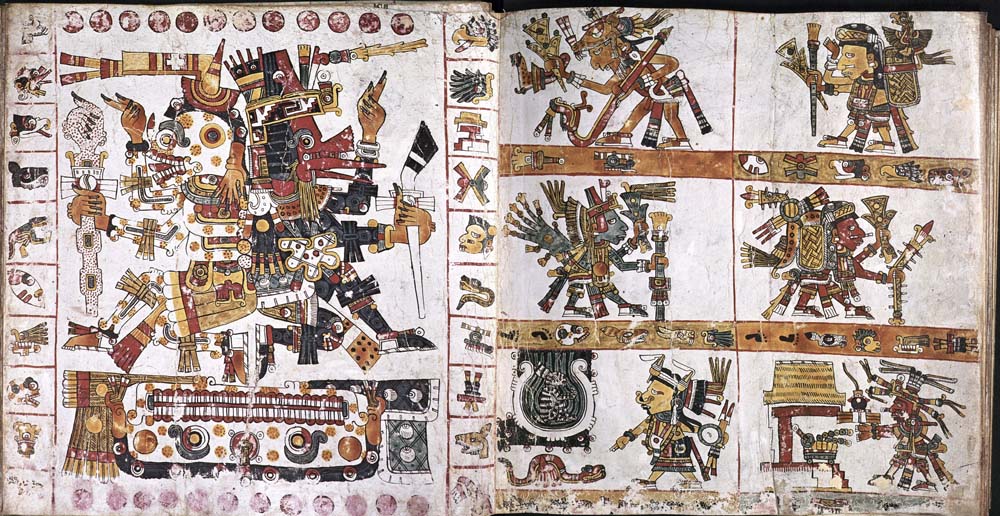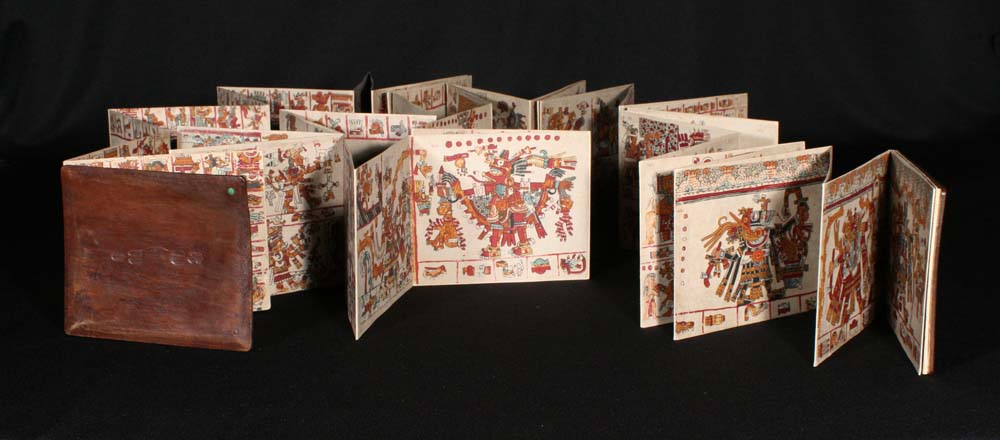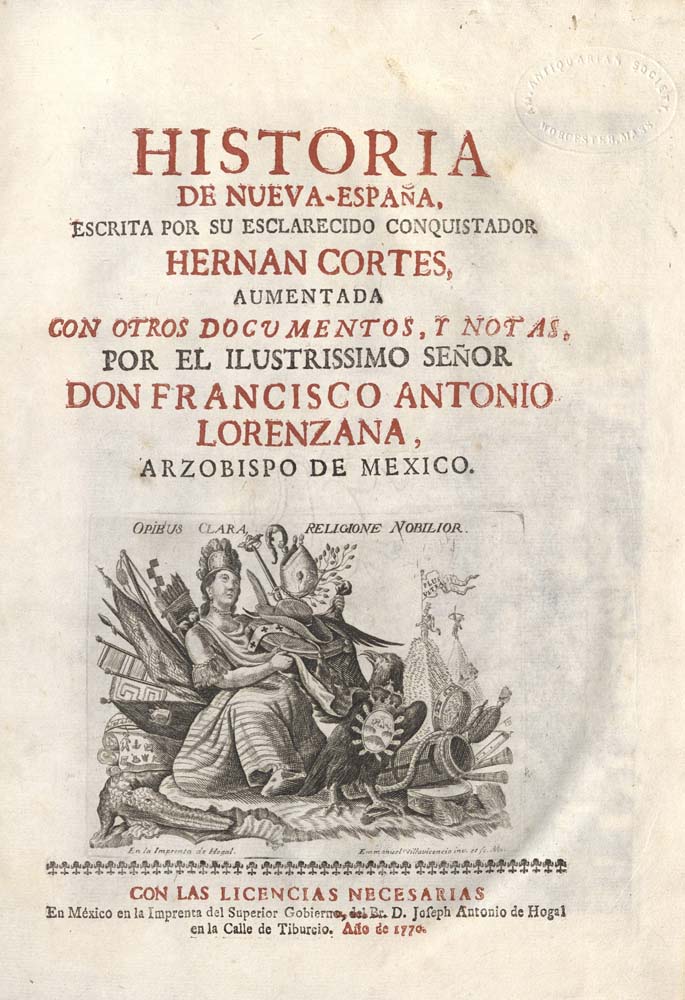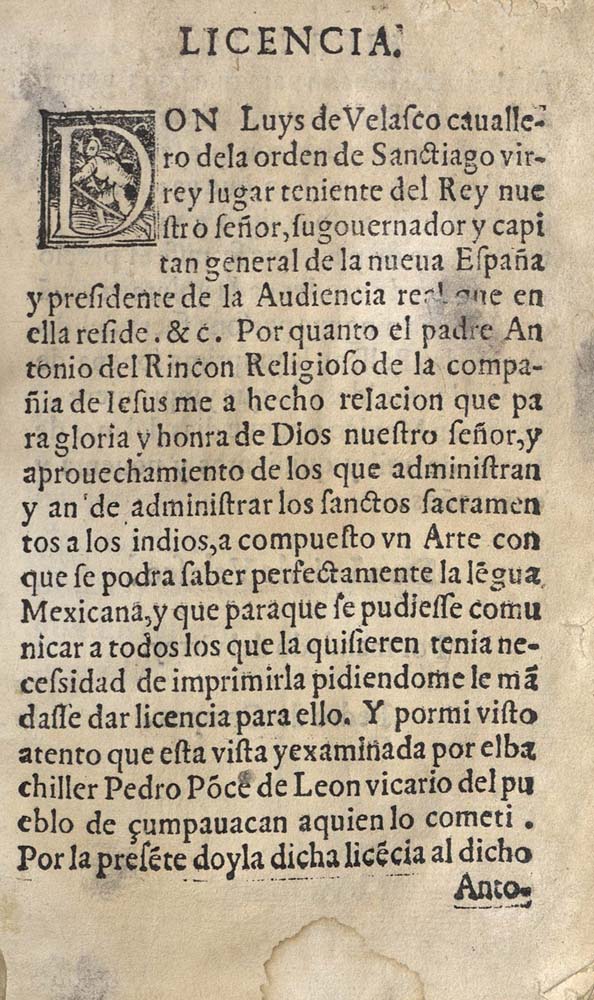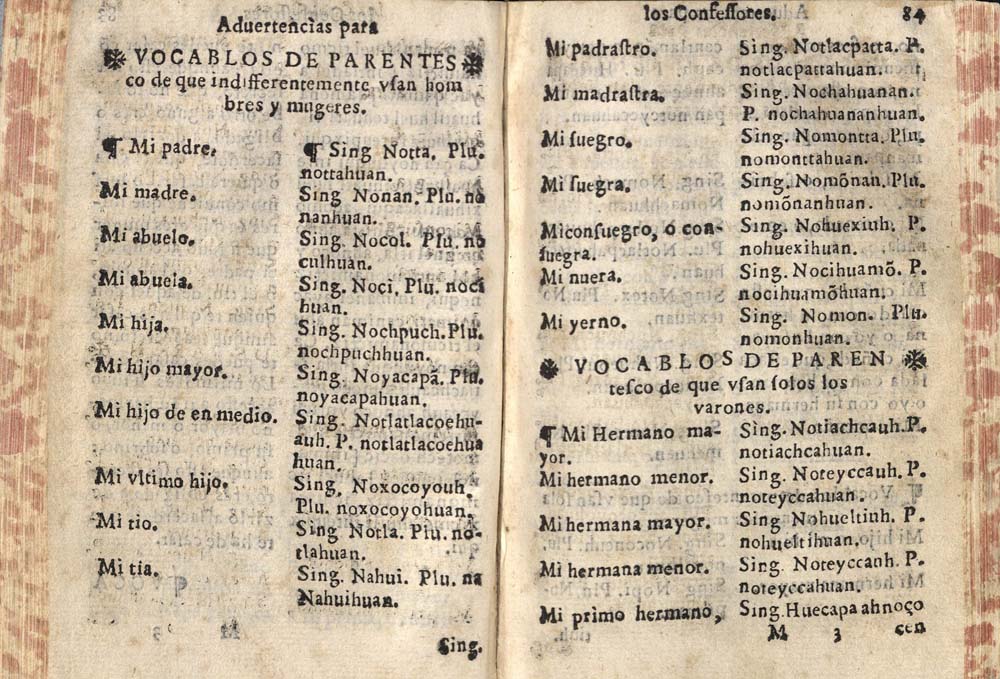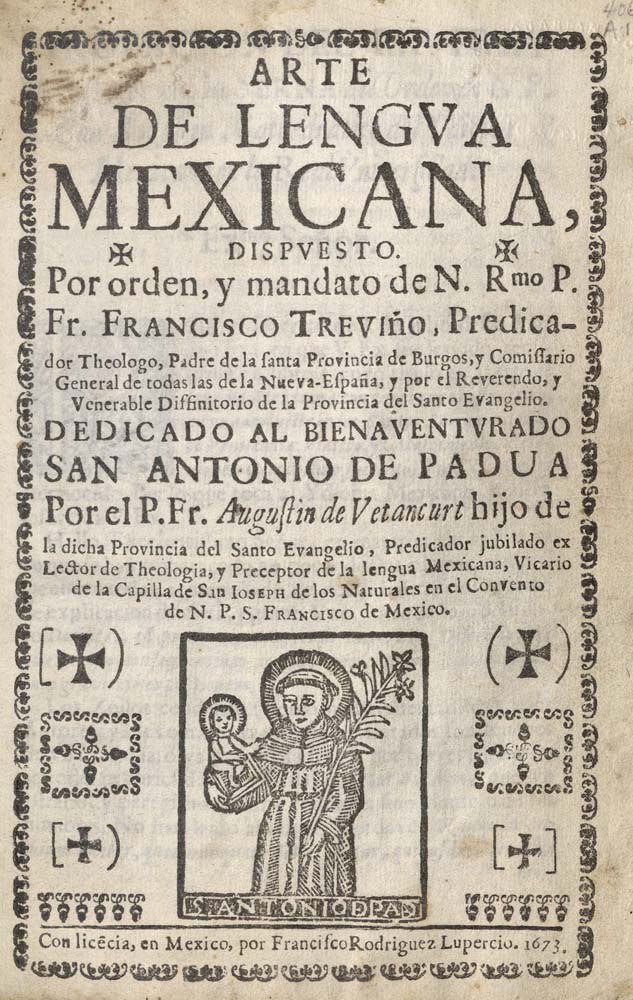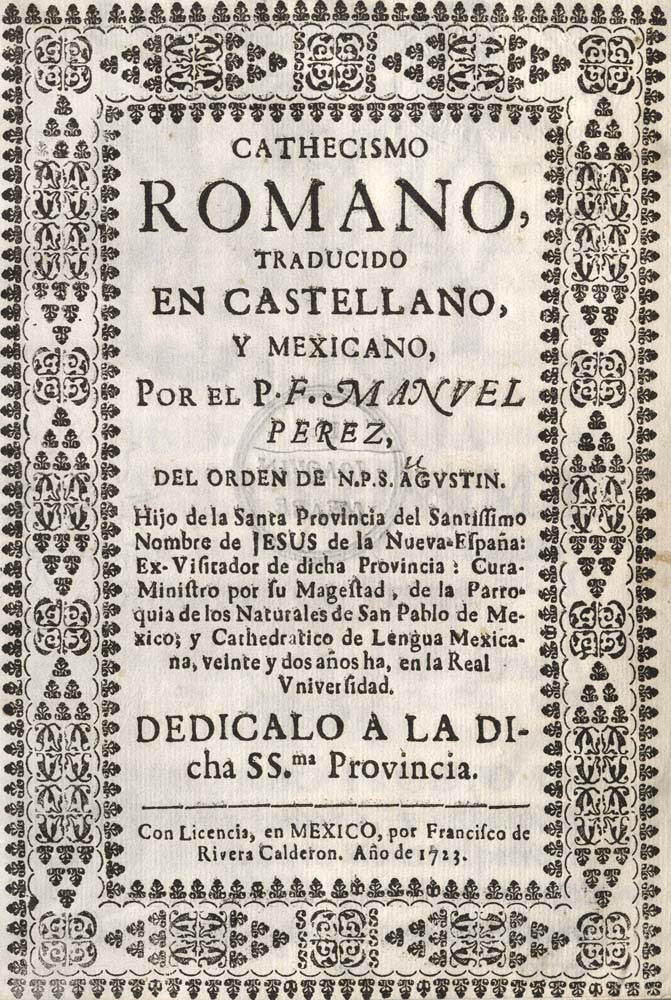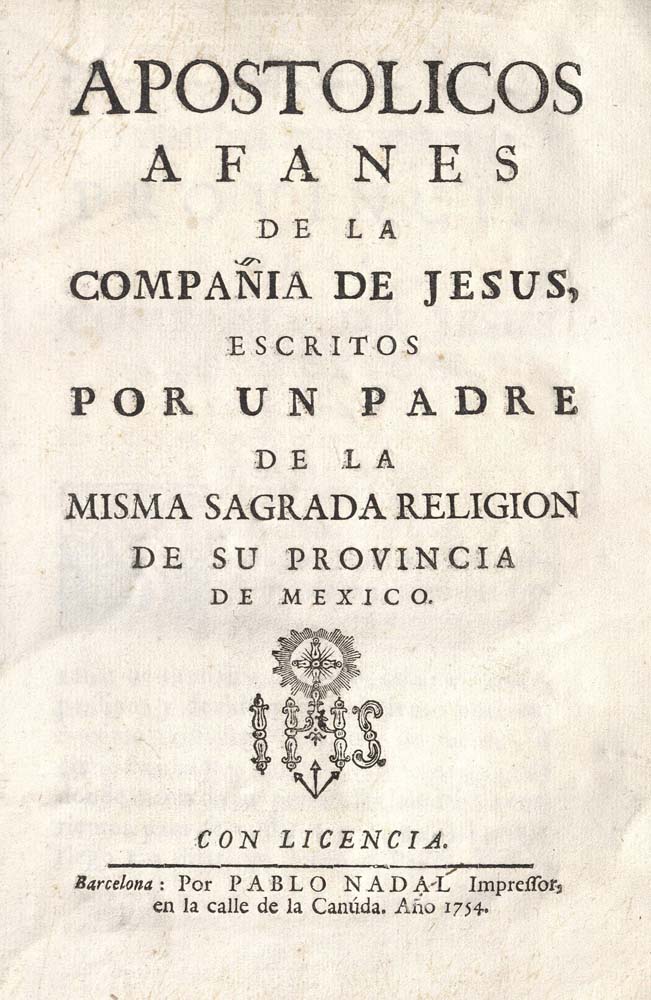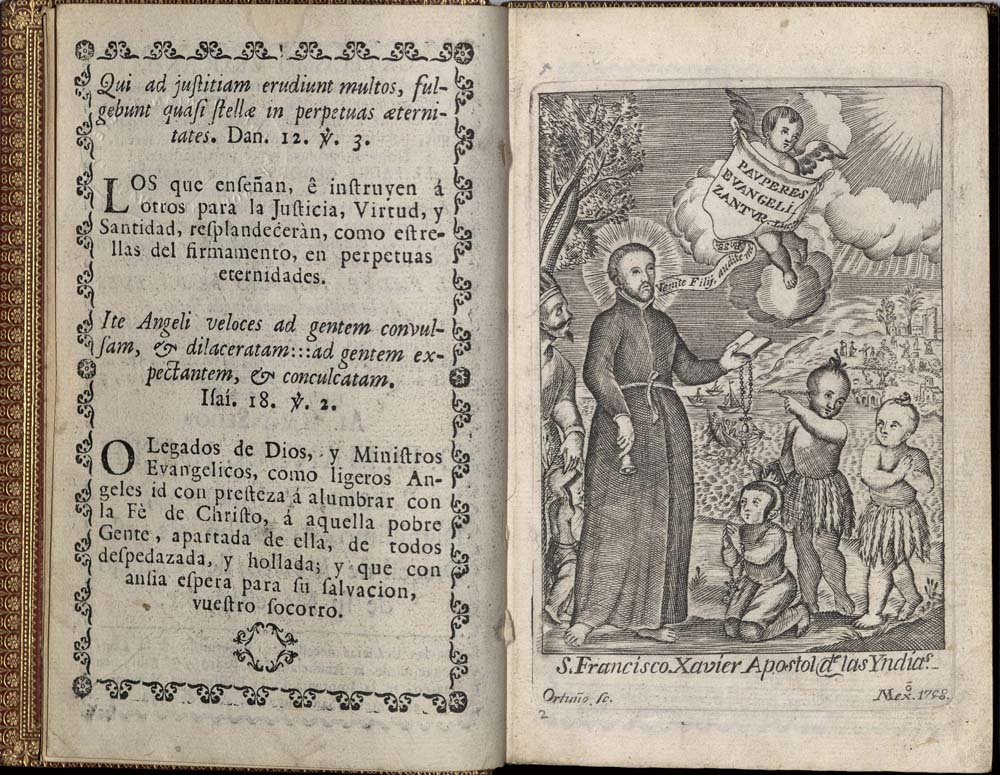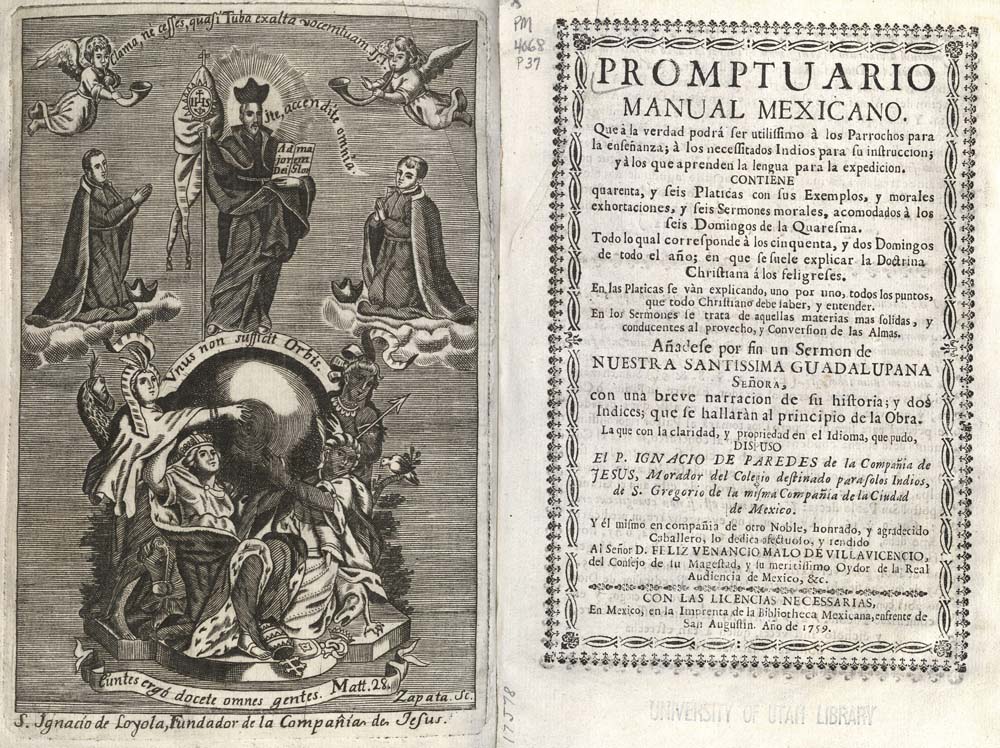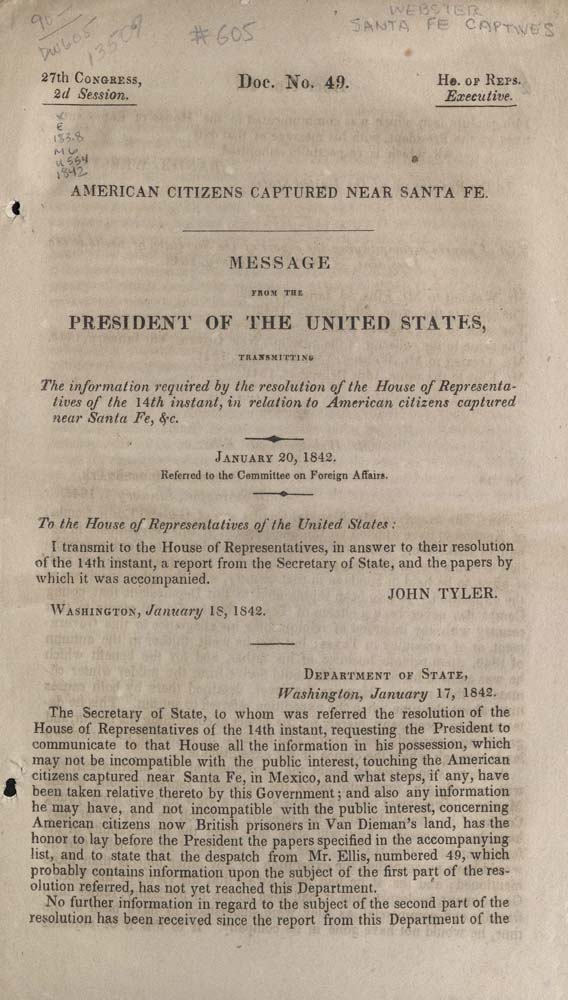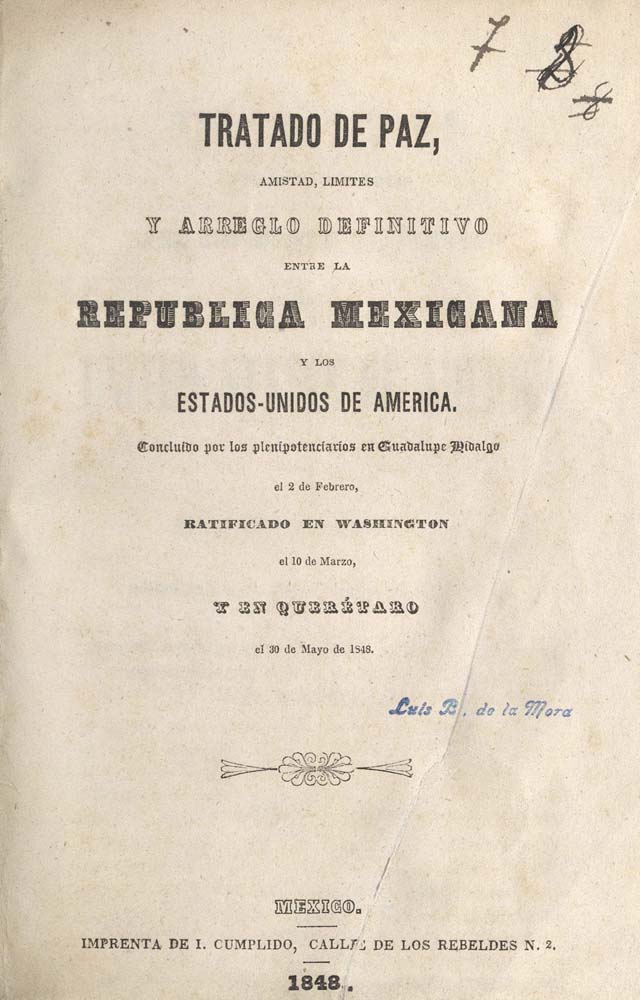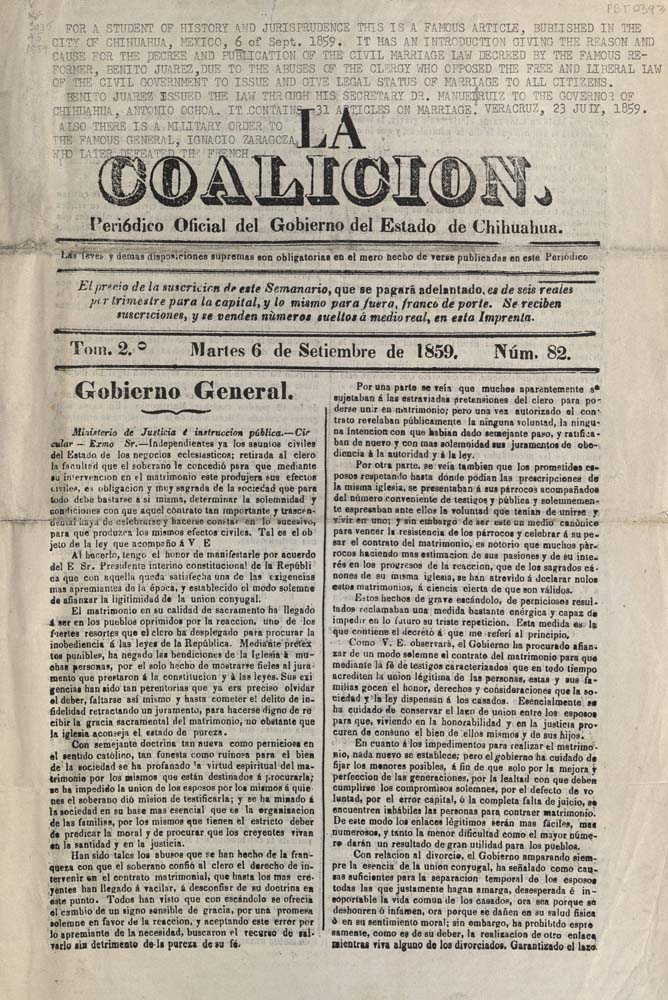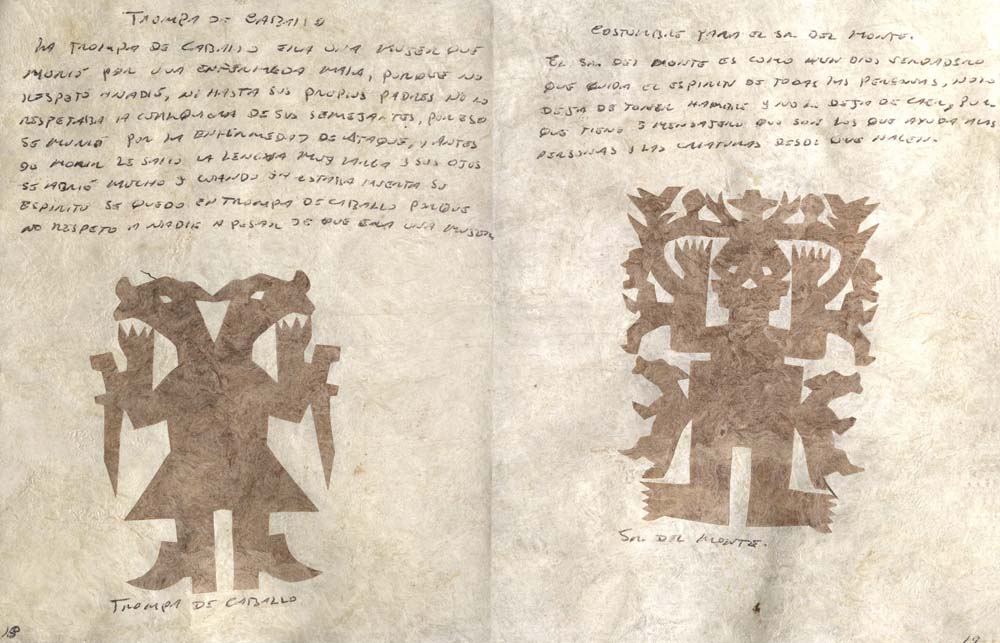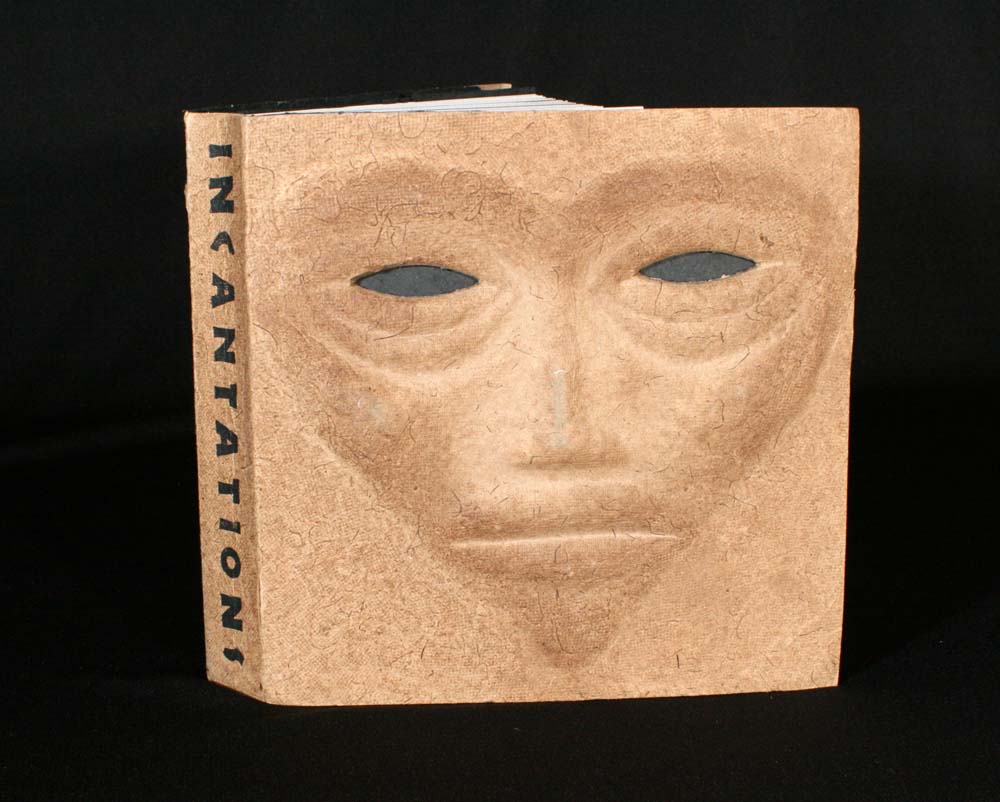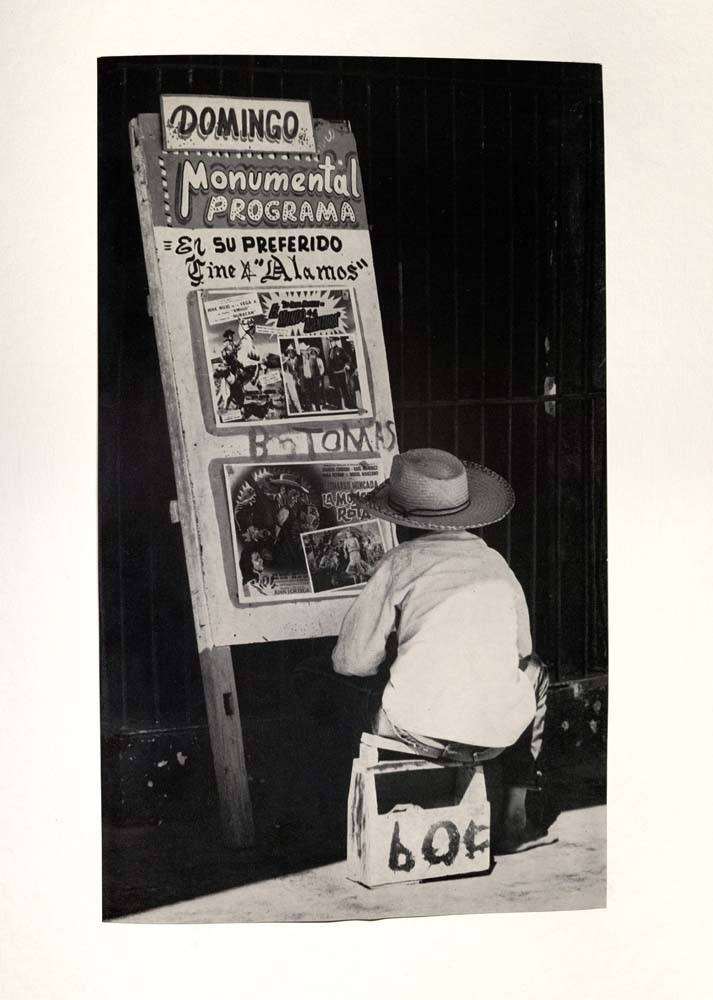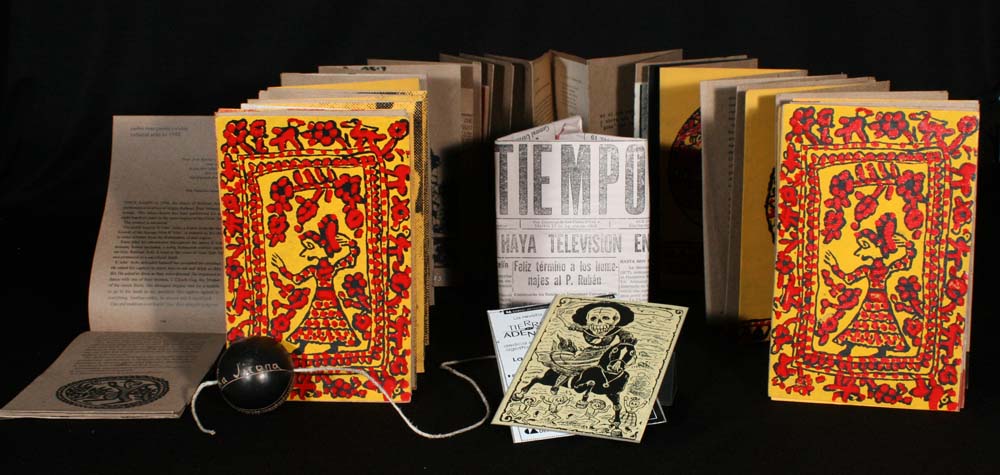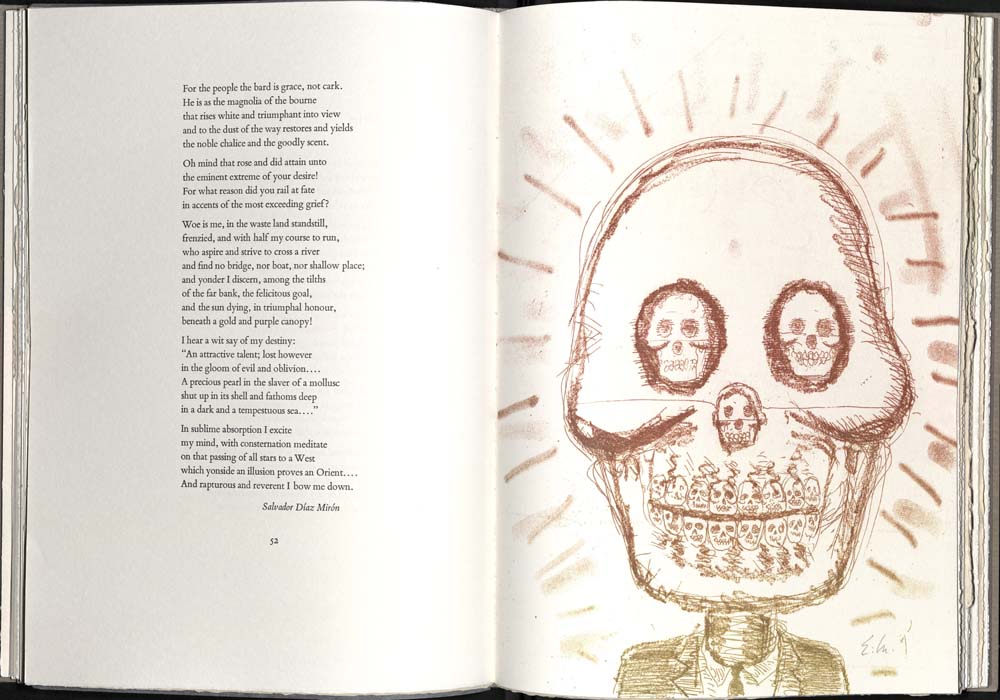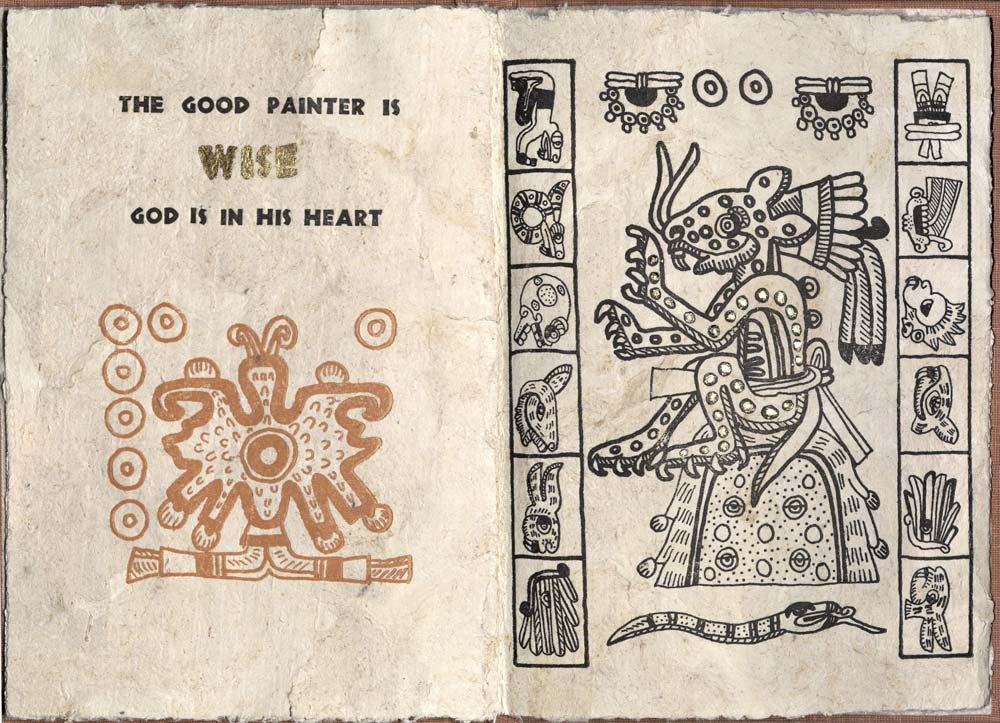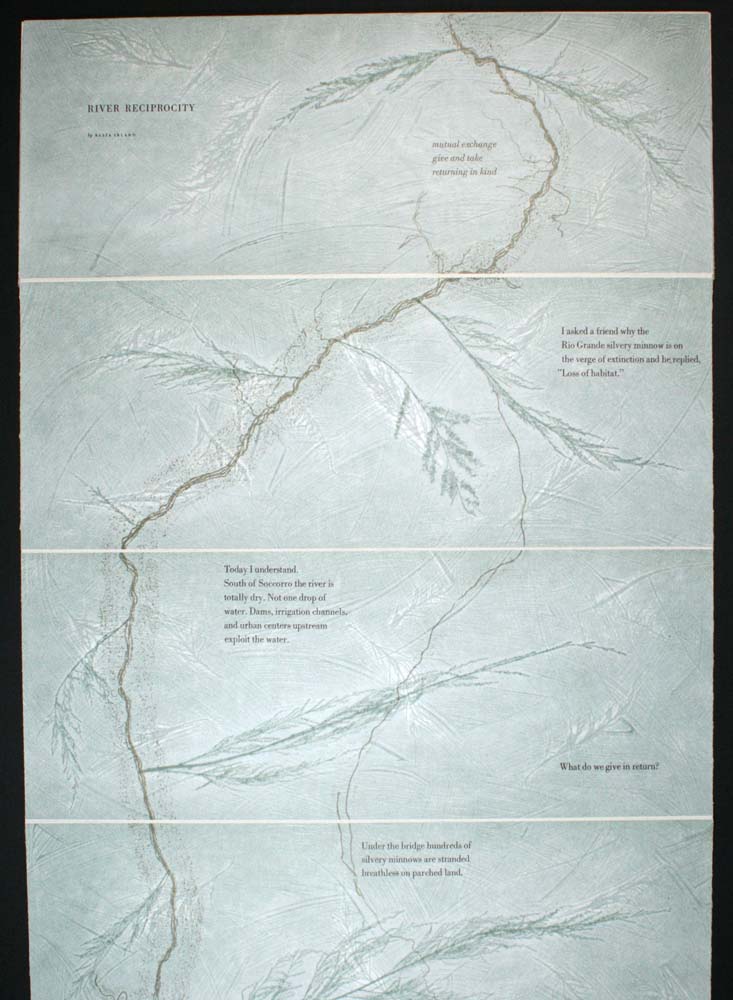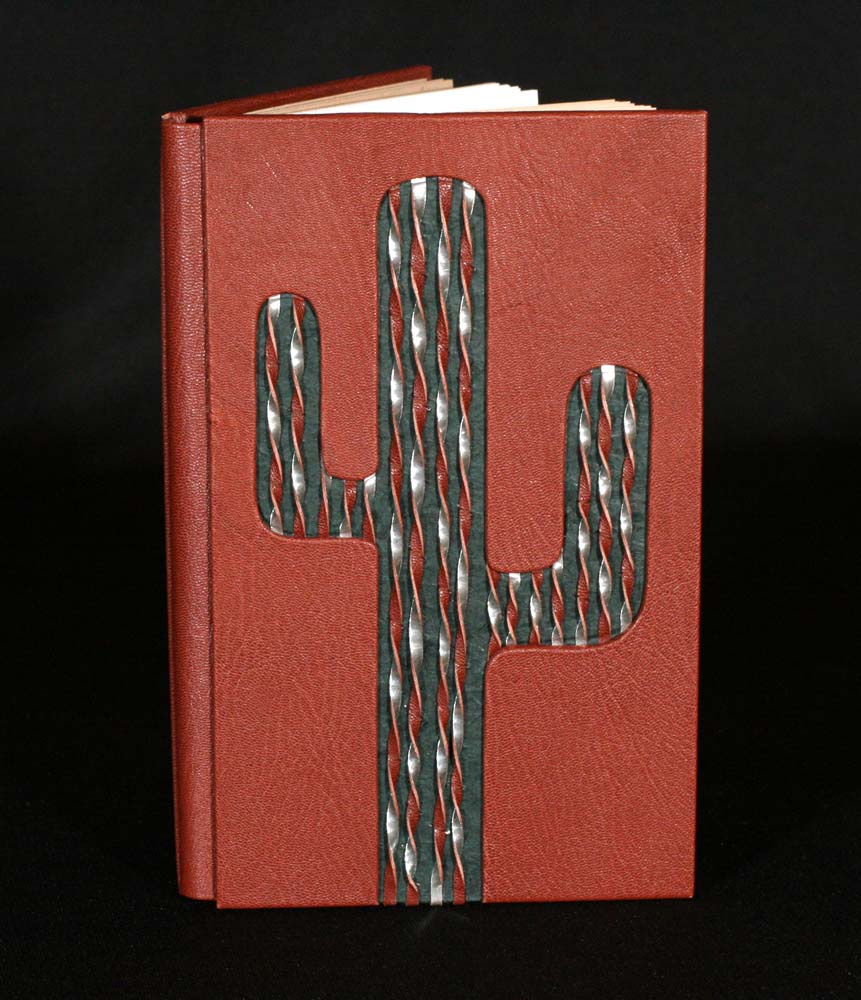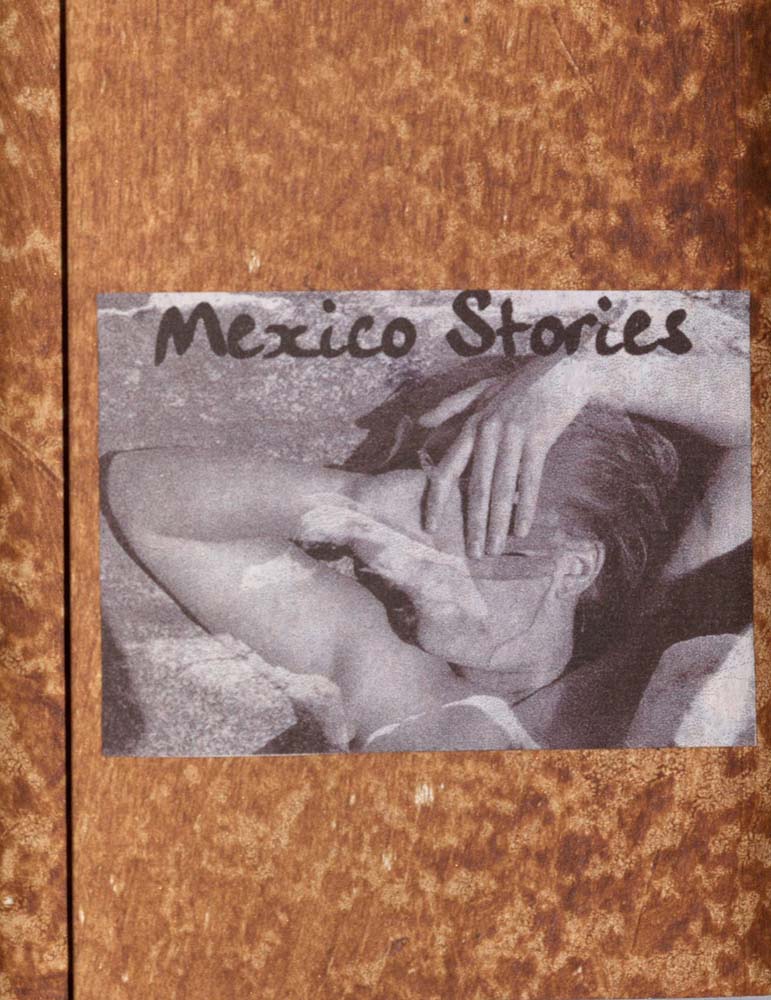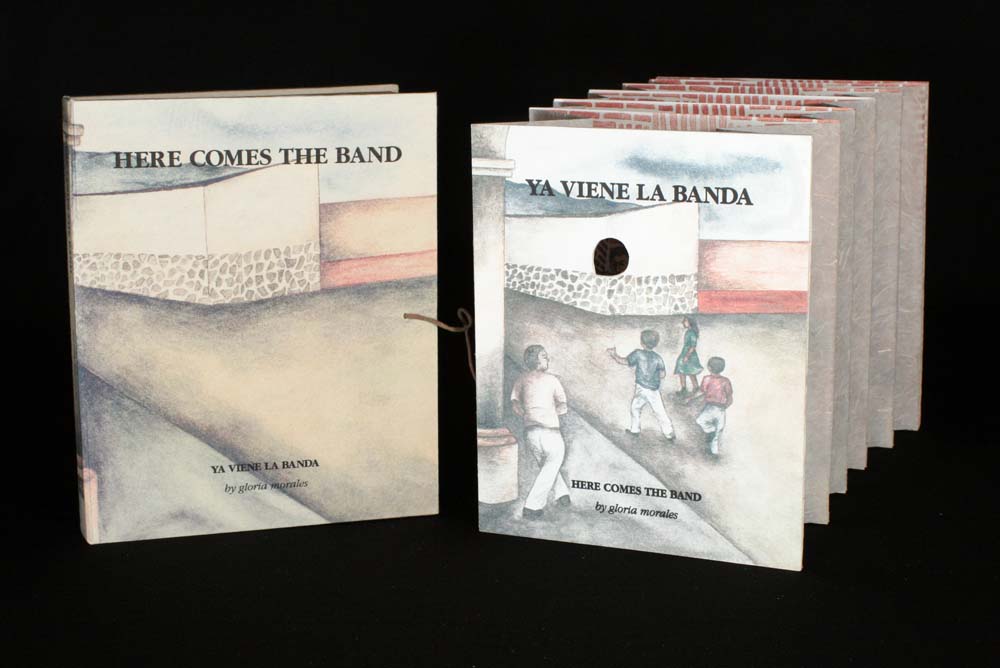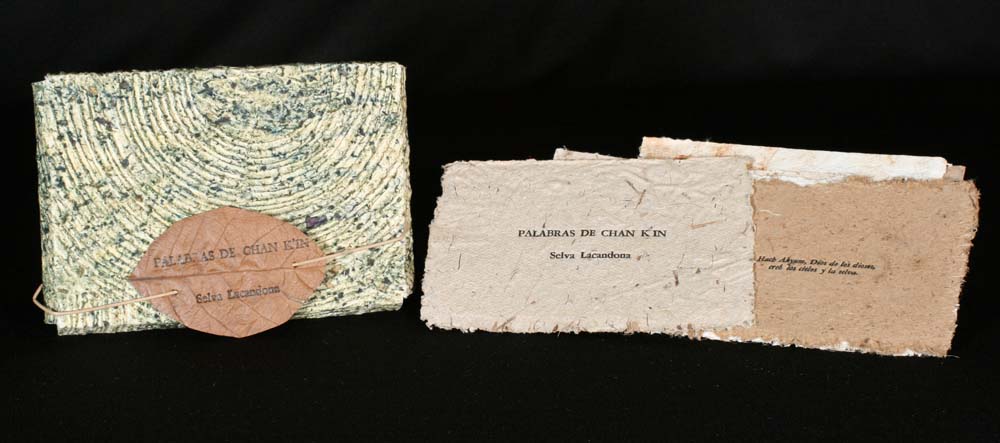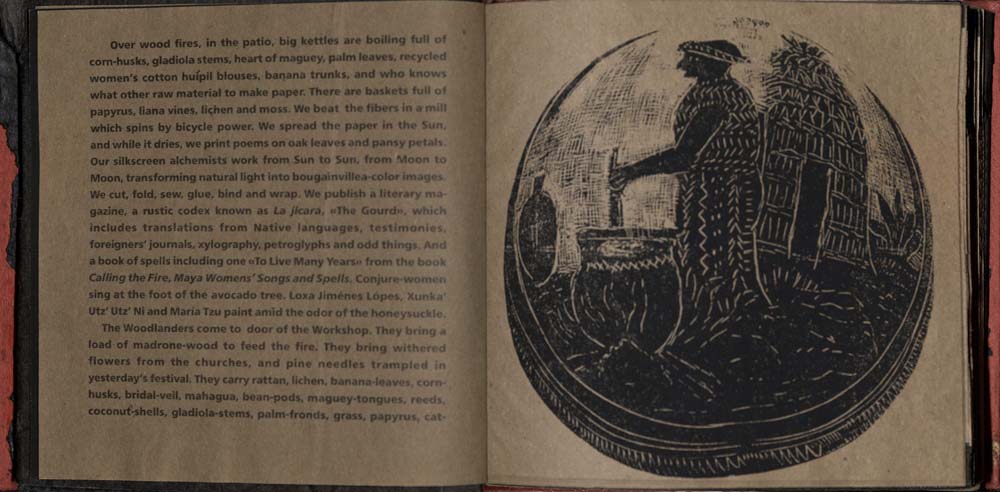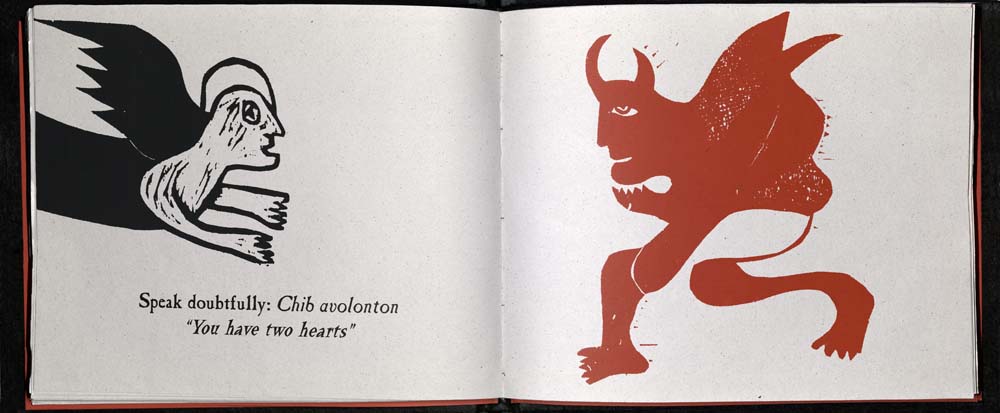¡Viva México!
Curated by Luise Poulton, 2010
Exhibition poster designed by David Wolske, 2010
Digital exhibition produced by Alison Elbrader, 2012
Format updated by Lyuba Basin, 2020
In recognition of the 200th anniversary of Mexican Independence and the 100th anniversary of the Mexican Revolution, the Rare Books Division presents a selection of Mesoamerican manuscript facsimiles; 16th through 19th century first and early editions of books that document México’s history of encounter, conquest, conversion, conflict, resolution and revolution; and 20th and 21st century artists’ books celebrating México’s artistic and literary heritage. ¡Viva México!
Mesoamerican Manuscripts – Pre-Conquest
REALIA CLAY STAMP WITH JAGUAR DESIGN
Eighth century
NK9504 C53
A Mayan artifact used for decorative stamping of fabrics and ceramics, and for printing on huun, or fig bark, paper.
REALIA BARK PAPER
TX1124 I63
Handmade paper from the fibers of the wild fig tree.
REALIA STONE BARK BEATER
Eighth century
TS1124 S76
A common artifact from the Valley of Teotihuacan, home of Aztec and Mayan peoples.
FACSIMILE
CODEX ZOUCHE-NUTTAL
Graz: Akademische Druck-u. Verlagsanstalt, 1987
F1219.56 C6253 1987
The Codex Zouche-Nuttal is a Mixtec manuscript. The traditional accordion-folded manuscript is pre-Columbian. Its cover was decorated with feathers and a colorful mosaic – the only known surviving Mesoamerican cover of its kind. One side of the screen-fold, divided into six sections records the genealogies, alliances, and conquests of the first and second dynasties in the eleventh and twelfth centuries of a small city-state in the Mexican highlands. The record ends past the marriage of Eight Deer. The Tilantongo kingdom disappeared before this thirteenth century copy was made. One of its leaders, Lord Eight Deer Jaguar Claw, was a powerful ruler whose reign lasted from 1030 until his death in 1115. He supported the Toltecs in their attempts at expansion. The codex gives the genealogy of the rulers of Teozacoalco through the children of the third rulers of the third dynasty. Other pages contain related genealogies of other families, some antedating the first Tiltantongo dynasty. Still other pages involve the divine origin of the Mixtec lineages. One scene in this codex depicts a ruling couple just below a hill at the center of the page, seated on a woven reed mat. Other male and female rulers are seated in temples.
FACSIMILE
CODEX BORGIANUS
Graz: Akademische Druck-u. Verlagsanstalt, 1976
F1219 C65 1976
The original ritual manuscript is believed to have been produced in southern or western Puebla, a Mexican state located east of México City. It consists of fourteen pieces of Mexican deer skin of varying length, glued together to form a continuous strip covered with writing on both sides, and folded into thirty-seven leaves. Except for the end leaves, the strips are painted on both sides. It is read from right to left. According to ancient beliefs reflected in this manuscript, the universe is populated by the gods of wind (Ecatotontin) and rain (Tlaloque). Of course, human beings also lived in this universe. Thus, religion and social order were inseparable.
FACSIMILE
IL MANOSCRITTO MESSICANO
Rome: stab. Danesi, 1896
F1219 V35
The original Nahua ritual manuscript resides in the Vatican Library, where it has been since the sixteenth century. The codex is a continuous strip, made up of ten attached sheets of deer skin, covered on both sides with stucco. It was arranged as a screen-fold with a wooden cover at either end. The original covers show traces of ornamental turquoise designs, but only a single piece of the gemstone remains. Although the page size is small, the whole document is one of the most extensive of Mesoamerican manuscripts. The painter arranged his material in such a way that by adjusting the length of each section, all pages are completely filled. This reference book defined various periods of the calendar with their meanings and variations, designating the sacred two hundred and sixty day period (tonalpohualli) as the most important. Several sections discuss mythological and ceremonial meanings and display the gods in their many aspects.
Mesoamerican Manuscripts – Post-Conquest
FACSIMILE
CODEX TUDELA
Madrid: Ediciones Cultura Hispanica, 1980
F1219.56 T86 C62 1980
Named after Jose Tudela de la Orden, this sixteenth-century Aztec codex is based upon an earlier pre-Columbian Aztec manuscript. Although there are very few surviving pre-conquest codices, the bookmaking tradition continued into the colonial period, under the watchful eye of the Spanish.
FACSIMILE
CODEX TULANE
Graz, Austria: Akademische Druck-u Verlaganstalt; New Orleans: Middle American Research Institute, Tulane University, 1991
F1421 T95 no.61
The Codex Tulane is one of several early Colonial manuscripts from the Mixtec-speaking region of southern México. The content is primarily genealogical, presenting lists of the native rulers of two Mixtec communities. The original was painted on six strips of animal hide overlapped and glued together. It was produced in the mid-sixteenth century for the native nobility. The format is a roll, or scroll. The codex contains the figures of one hundred and twelve male and female figures, common to genealogical manuscripts. The female figures are depicted seated opposite their husbands. Twelve men are seated flanking a campfire, the standing men are priests, two deities are dressed in animal costumes. One man is seated on the left side of a body of water that represents the name of a town. The Codex Tulane is likely an anthology of material drawn from older, now lost, pictorial manuscripts. The opening scene of the Codex Tulane depicts an offering made to two deities who are associated with a Hill of the Palm Tree. These specific deities appear in other Mesoamerican codices.
Encounter and Conquest
Fue impressa…en… Seuilla en las casas de Jacome Croberger. Acabose a diez siete dias del mes de Agosto ano de mill quinientos cinquenta y dos anos. (1552)
F1411 C32
Bartolomeo de las Casas, the first Roman Catholic Bishop of Chiapas, was a major force behind the passage in 1542 of Spanish laws prohibiting Indian slavery and safeguarding the rights of the Indians. He was met with powerful opposition for his pleas on behalf of the Indians, but he captured the attention of Charles V, who eventually made de las Casas a bishop for his philanthropic work. De las Casas marred his record as a social reformer by condoning the enslavement of black Africans in order to spare the Indians. His writings were widely translated and widely read. English translations of his works were used to foment English feeling against the Spanish and to promote the belief that Spanish colonies would be better off in English hands. In 1525, a Royal Order granted printer Jacobo Croberger a monopoly on the book trade in New Spain. In 1539, printing was established in the New World through a contract between Croberger and another printer.
México: Impr. Del superior gobierno, J. A. de Hogal, 1770
First edition
F1230 C82
This set of letters from Hernán Cortés to Carlos I, King of Spain, were reports carefully designed to defend Cortés’ credentials as commander and loyal subject, justifying his shaky legal position. The letters were embellishments of the conquest of Tenochtitlan, depicting Cortés as an extraordinary military strategist winning a new empire for his king. Cortés wrote five letters. One is lost; another, lost and recovered in the mid-nineteenth century. The three surviving letters were first printed in this edition, illustrated with copperplates designed and engraved by Manuel Galicia de Villavicencio of México and a map by José Mariano Navarro based on a 1541 representation of the coast of “Mar de el sur.” This edition also included a reproduction of a Mexican manuscript illustrating tribute paid in kind to Moctezuma, a list of viceroys from Cortés to the Marquis de Croix, an account of Cortés’ voyage to Baja California, and a report of all subsequent expeditions to California up to 1769. The edition is a masterpiece of Mexican colonial printing including a title-page in red and black with a large engraved vignette and pictorial initial on the dedication page. The editor, Antonio Lorenzana, archbishop of México from 1766-1772, deliberately promoted the printing arts in México during his term. This book was the most lavishly illustrated book to have been printed in New Spain up to 1770.
Conversion
Arte Méxicana, a grammar of Nahautl, is the first printed work by a mestizo, the first published indigenous-language work written by a native Nahautl speaker, and the first work in an indigenous language of México written by a Jesuit. Born not quite two generations after the completion of the conquest of México, Antonio del Rincon was a native of Texcoco, a descendant of the tlaloque, the nobility of Texcoco. It is likely that his family was still using Nahautl as its first language. Rincon was as facile in Nahautl as he was in Spanish. He entered the Jesuit order at Teopoztlan in August of 1573, the year after the Jesuits arrived in México. Rincon’s comprehension of Nahautl as it was spoken in the post-Conquest period was particularly helpful in creating this successful grammar. Rincon was the first Mexican linguist to recognize the significance of certain aspects of Nahautl, such as the duration of the sounded vowel and the glottal closure. Rincon also first proposed the interpretation of the meaning of the name “México” as “in the middle of the moon.” His grammar was in constant demand for nearly a century, until its use was eclipsed by a 1645 grammar produced by another Jesuit. Rincon’s grammar contains an eighteen page list of all the Nahautl words used in his grammar. The book contains eight woodcut initials, five of which are historiated. Printer Pedro Balli was a native of Salmanca who arrived in México sometime around 1569 as a bookseller. Pedro Balli was the fourth printer of record in New Spain by royal decree of King Philip II. His first publication appeared in 1574. The title-page has one of the earliest instances of the Jesuit imprint in México.
En México: Enel Conuento de Sactiago Tlatilulco, Por M. Ocharte, ano 1600
First edition
BX1757 J8 v.1-v.2
Juan Bautista was born in México. A professor at the College of Santa Cruz de Tlatelolco, he was a prolific writer, publishing more in México than any other author in his lifetime. Advertencias, directed towards confessors of indigenous penitents, is a comprehensive handbook based on canon law. The first volume of this edition, printed in double columns, was written in Spanish and Nahuatl, punctuated with quotations in Latin. Bautista suggested that confessors (and other church ministers) carefully regard their own actions in light of their faith. He urged confessors to be flexible and supportive when taking confessions regarding incest, marital infidelity and other sins. Above all, he pled for mild and charitable interactions with the Indians. His approach was in contrast to the strict Dominican administration. Still, Bautista, like the Dominicans, denied the intellectual ability of the Indians to understand or accurately describe their sin. Beyond the basic tenets of faith, they could not be trusted to understand more. Bautista was particularly sensitive to accuracy of translation between Spanish and Nahuatl and Latin and Nahuatl. He delved into Nahuatl to find native words, instead of relying on Spanish loan words. Bautista believed that the difficulty of translation, in particular of the three-in-one formulation of the Trinity, was partly to blame for the inability of the Indian to confess in the manner of the Europeans. Title vignettes (emblem of the Franciscan order; initials; woodcut (emblem of the Franciscans, different from that on title-page. Some marginalia in contemporary hand, v. 2.
En México: por F. R. Lupercio, 1673
First edition
PM4063 A1
Augustin Vetancurt was a Franciscan scholar of Nahuatl. In the seventeenth century the study of Nahuatl reached its apex through the dedicated work of sixteenth century Franciscan scholars. Vetancurt’s Nahuatl grammar includes a comprehensive index, a short catechism, and instructions on the commandments and the sacraments of the Roman Catholic Church. Vetancurt begins his grammar with the insight that proscribed study of European languages had its shortcomings when applied to New World languages, although in the end he was hard-pressed to find his way around contemporary pedagogy.
México: F. De Rivera Calderon, 1723
First edition
BX1958 S6 1723
In 1585, Mexican bishops authorized an official catechism that differed from that of the Roman Catholic Church. This translation from Latin into Nahuatl by Manuel Perez is of the accepted Roman catechism.
Published anonymously, this was unofficially recognized as the work of Father Ortega early on and then later officially recognized in an 1887 reprint. The work consists of an account of the conquest of the province of Nayarit; the beginning, progress, and decline of the spiritual conquest of the province of Pimeria Alta; and the progress, various discoveries, and contemporary state of Pimeria Alta. It ends with a diary of a voyage made by Father Consag in 1751 north between the Sierra Madre range and the ocean. For the sections on Pimeria Alta, now northern Sonora and southern Arizona, the author states that he found a collection of the papers of Father Kino, who founded the first mission there. Ortega culled information from various Kino manuscripts and other sources. One of Kino’s manuscripts that Ortega claimed access to, however, is in question. Another writer claimed to have had access to it in Spain, whereas Ortega was writing in México during that same time. It is possible there were two manuscripts of Kino’s original work. Pimeria Alta was named for the Pima and O’odham peoples of the Sonoran Desert. The Pima launched a fierce but failed revolt for independence from Spain in 1751.
México: Imprenta de la Bibliotheca mexicana, 1758
First edition
PM4068.1 R5
Spanish Jesuit Geronimo Ripalda is known for his Catechism, first published in 1618 and which went through several editions. This translation into Nahuatl, by Ignacio de Paredes of Ripalda’s Cathechism was well-received and was used as the official translation until the Second Vatican. The book is printed in Spanish and Nahuatl, with preliminaries and headers in Spanish. Paredes introduced the work with an essay on “Reason for the work to the reader,” in which he stated that the first reason is to have a brief teaching manual and second, to have a single text for Mexican Christians since the Castilian catechism of Ripalda “is used everywhere.” The catechism is preceded by a description of saints and religious festivals. There is also an explanation of doctrine and then a discussion of doctrine in the form of questions and answers. It is this front matter that makes this publication important. The volume is completed by a “small Doctrine” of Bartholomew Brown, a Jesuit. The book, as a whole, is a practical manual. The work was reprinted in México in 1809 and 1831. Ignacio Paredes, born in San Juan de los Llanos, México in 1704 became a Jesuit and spent his life making a thorough study of Nahautl.
México: en la imprenta de la Bibliotheca mexicana, 1759
PM4068 P37
This volume contains forty-six essays, or talks, and six sermons, a total of fifty-two readings, one for each Sunday in a year, in Nahuatl. It also contains a special sermon on the Virgin of Guadalupe. The talks touch upon major themes of Christian dogma, in the order of the catechism, and are structured in four parts: introduction, statement of theme, example and moral exhortation. Seven sermons were placed at the end of the volume, numbered in Roman numerals. The first six explicated the six Sundays of Lent and dealt with death, hell and the glory of the blessed. The sermon on the Virgin of Guadalupe is “the story of her admirable and miraculous appearance.” It recreated a dialogue between the Virgin and Juan Diego preceded by a description of the Virgin of Guadalupe by St. John in Revelation. This sermon essentially placed the Virgin of Guadalupe within a universal framework of the New Testament and demonstrated the appearance and dwelling in New Spain of the Lady of Heaven. De Paredes set the appearance in recent times, talked of its announcement in the Gospel and described it as an expectation by all of Christendom. The entire volume constitutes an example of the evangelical literature adapted to the new form of preaching developed in the eighteenth century in México. De Paredes offered a new book of usual topics, sermons which “[address]…eternal truths about good and move conversion of Souls.” Frontispiece engraved with coat of arms. University of Utah copy bound in vellum.
Increased mining of silver in eighteenth century Mexico resulted in increased wealth for the mine owners and the crown. Only miners born in Spain were allowed to possess copies of this book of royal decrees regarding the mining industry. The decrees addressed the discovery of new mines; the operation of old ones; the training of workers and royal officials; the duties of experts; the introduction of new technology; the role of the Tribunal de la Minería, and the requirements (including purity of blood) for appointment to it; and many more aspects of the most important economic activity of México’s colonial period.
Conflict
Washington, D.C.: The House, 1842
E183.8 M6 U554 1842
On June 21, 1841 an expedition made up of one battery of artillery, more than two hundred soldiers, and fifty merchants (accompanying a long wagon train filled with merchandise) and other citizens headed from the Republic of Texas toward the Mexican province of New Mexico. The expedition was organized by then Texas president General Mirabeau B. Lamar, who charged the group with finding a new route over which to open direct trade with México. Lamar believed that the citizens of New Mexico were discontent and ready for revolt. His hope was to bring the area on the eastern side of the Rio Grande into Texas. In the event that this takeover failed, Lamar directed the Texan traders to make a commercial treaty with the Mexican authorities. The expedition wandered through thousands of miles of unknown territory, was beset by hostile Indian tribes, and nearly starved to death. In the end, the group was taken prisoner by Mexican troops, their goods confiscated, and marched to Mexico City. George Wilkins Kendall, an American traveler with the expedition, was held for nearly a year before his United States citizenship gained him release. In 1837, Kendall and a partner ran the first issue of the New Orleans “Picayune.” He joined the Texan Santa Fe Expedition as a reporter. After his return to New Orleans he published a series of articles about the disaster for his paper and eventually put the articles together in a two-volume set whose first printing sold forty thousand copies. This document contains inquiries made by the United States concerning George W. Kendall and Franklin Coombs, another of the expedition’s captured American citizens.
Resolution
This is the second official Mexican printing of the Treaty of Guadalupe-Hidalgo. The second printing included protocols necessary for the conclusion of the treaty. The full text appeared in English and Spanish on facing pages. Amendments made to the treaty by the United States were added, followed by a statement by Mexican commissioners accepting the modifications. Mexican signatories stressed that México was poor, internally divided, and unprepared for a struggle with a much more stable and prosperous United States. The treaty ended war between the United States and México but resulted in the loss of fifty-five percent of Mexican territory: what is now New Mexico, California, Arizona, Texas and parts of Colorado, Nevada and Utah. México’s independence from Spanish rule in 1821 had propelled it into the modern age. But on the heels of independence came devastating invasions, particularly those by the United States. Under these conditions, printed material was often of limited production. A lack of basic materials such as movable type and paper curtailed the Mexican printing industry. Still, there were many printers in nineteenth century México. Ignacio Cumplido (1811-1887) was it’s most prolific. He printed calendars, newspapers and magazines and became known for the high quality of his work. Cumplido made several trips to Europe and the United States to obtain type and presses. These trips also allowed him to remain knowledgeable on methods of print production and style. He helped to consolidate a Mexican visual identity built on a diversity of European and American typographic elements and styles blended with Spanish tradition.
Benito Juarez was the son of Zaputeco Indians who died when he was very young. Juarez studied for the priesthood, but changed his focus to law, receiving his law degree in 1831. That same year, he won a seat on the municipal council. In 1841, he became a judge and the governor of Oaxaca. Juarez was exiled to New Orleans in 1853, when conservatives took over the government. Two years later he returned to México with a new liberal government as the Minister of Justice, presiding over the Supreme Court. In 1858 conservatives again took over the government. Juarez went to Vera Cruz, where he created a government in exile. In 1861 he became President of México. He was the first Mexican leader who did not have a military background and the first full-blooded indigenous national to serve as President or, for that matter, to lead any country in the Western Hemisphere. As President, he resisted French occupation, restored México to a republic, promoted equal rights for the Indian population, and reduced the political and financial power of the Roman Catholic Church, in part by confiscating church property.
Revolution
HISTORIA GRAFICA DE LA REVOLUCION, 1900-1940
Mexico, D.F. : Archivo Casasola, 19—
F1234 C424
A founder of the Mexican Association of Press Photographers, Agustin Casasola began working as a newspaper typographer, later becoming a reporter and finally settling on his interest as a photojournalist sometime between 1904 and 1906. The timing of this career change could not have been better. Casasola’s photographs documented presidential festivities, firing squads, the extremes of Mexican wealth, provincial and government armies, prim schoolgirls, female soldiers and shoe factory workers. They documented the political, economic and social changes of Mexico during the early decades of the twentieth century. As a collection, they reveal the cross-cultural tumult of transition. When the newspaper, El Imparial, folded in 1914, Casasola collected its archives, saving negatives from destruction. He used many of these photographs for his Album Historia Graphico, covering the events of the Mexican Revolution.
Ceremony
HISTORIA DE UNA CURACION DE ANTIGUA, DE SAN…
Puebla, México, 1978
F1221 O86 G373 1978
Accordion-folded amate paper, hand-lettered and illustrated with cut-out figures on amatl. The paper is particular to the place where the book was made. The figures are based upon ceremonial figures usually burned at some point during the ceremony. University of Utah copy is gift of Patrick Eddington.
CONJUROS Y EBRIEDADES: CANTOS DE MUJERES MAYAS
San Cristobal de las Casas, México: Taller Lenateros, c1997
PM4466 Z95 C66 1997
Prologue by Juan Banuelos. Prose in Spanish, verse in Tzotzil with Spanish translations. Poetry written in collaboration with Xun Okotz and Petra Emandes about Tzotzil shamans in Chiapas. Embossed papers, top cover is a sculpture of a face.
INCANTATIONS BY MAYAN WOMEN. FATHERMOTHERS OF…
Chiapas, México: Taller Lenateros, 2005
Second edition
PM4466 Z95 E533 2005
Text (essays in English, poems in English and Tzotzil) is taken from Conjuros y ebriedades: cantos de mujeres mayas. Illustrations printed in black on off-white art paper. The three-dimensional cover, a mask, was cast from recycled cardboard, corn silk, and coffee. The mask represents the Mayan earth goddess Kaxail. Her eyes open onto handmade endpapers blackened by soot and studded with palm fronds. Illustrated with silk-screen prints based on ancient Mayan folk-art patterns. Issued in a brown cardboard clamshell box, painted and stenciled in black, lined with the same black endpapers used in the book.
PORTABLE MAYAN ALTAR: POCKET BOOK OF MAYAN SPELLS
San Cristobal de las Casas, Chiapas, México, 2007
PM4466 Z95 E5333 2007
Translation from Tzotzil to English by Ambar Past. Text from Conjuros y ebriedades: cantos de mujeres mayas. Three volumes in hut-shaped cardboard carrying case that can be folded out into an altar with two side panels. Includes one pot-shaped clay burner, two animal-figure clay candles and twelve colored candles. Incantations include “Hex to kill the unfaithful man” by Tonik Nibak, “Mayan love charms” by Petra Hernandez and “Magic for a long life” by Manwela Kokoroch. Volumes 1 and 3 issued in editions of one hundred copies. Volume 3 issued in an edition of one thousand copies.
Arte Méxicana
XOCHIMAPICTLI: COLECCION DE POEMAS NAJUAS
México: Ediciones culturales, Mexicanas, 1959
PM4068.6 X62 1959
Garibay Kintana was a Mexican linguist and historian of pre-Columbian Mesoamerica. As a seminary student, he studied Spanish, English, French, German, and Italian. As a Roman Catholic priest, he was particularly interested in the Nahua peoples. He translated conquest-era Nahuatl documents. In 1940, in Otumba, he published Llave del Nahuatl (A Key to the Nahuatl Language). The book was used by notable Mesoamerican scholars such as University of Utah professor Charles E. Dibble, an internationally recognized translator of Nahuatl codices. This collection of poems in Nahauatl is translated into Spanish on facing pages.
ALAMOS: A PHILOSOPHY IN LIVING
San Francisco, CA: Grabhorn Press, 1965
Z232.5 G7 E44 1965
Forward by author Barnaby Conrad (1922-), a California native who attended the University of Mexico, where he studied painting and began a career as an amateur bullfighter. Edition of four hundred and eighty-seven copies. University of Utah copy is no. 91, signed by Richard J. Elkus, and printers Edwin and Robert Grabhorn.
EL SOL Y LOS DE ABAJO
Sherman Oaks, CA: Ninja Press, 1992
PS3563 O54525 S6 1992
José Montoya studied art at the California College of Arts & Crafts and California State University. He helped found the Rebel Chicano Art Front, later renamed the Royal Chicano Air Force, in the 1970s. The RCAF organized cultural, educational, and political activities in the Sacramento area. Binding cover is handmade cogon grass paper from the Philippines. Typeface is Spectrum. Drawings printed from zinc plates. Design, presswork and binding by Carolee Campbell. Edition of 195 copies, numbered and signed. University of Utah copy is no. 131.
MEXICAN GOTHIC: POEMS
Lincoln, NE: Blue Heron Press, 1993
PS3554 A48 M49 1993
Inspired by the home of painters Diego Rivera and Frida Kahlo, this is a tale of a rebirth of life through the grand feast day of death, el Diá de los Muertos. The book creates life-size calavera for vertical display. Woodcuts by Karen Kunc. Six sheets, printed on one side, joined to form a continuous strip, folded accordion style. First and last sheets are cut-outs. Printed from 10pt. Garamont light types. Multi-color reduction woodcut on Frankfort cream paper. Issued in black paper slipcase. Signed by the author and the artist.
LA JICARA
Casa de las imagenes (San Cristobal de Las Casas), Chiapas, México); Taller Leñateros, 199-
F1256 J53 1990z
Taller Leñateros was founded in 1975 by Mexican poet Ambar Past. In 1992, Taller Leñateros began “La jícara” (The Gourd), a literary, artistic and historical journal to preserve and promote Mayan culture. Only historical documents or material created specifically for the journal and never before published would be used. The first trial issue, unnumbered, was produced in an edition of 200 copies. The first official issue was produced in 1994. Issue no. 2, focusing on literature of Chiapas was produced in an edition of 700 copies. Production grew to 1,000 copies in later editions and explored topics such as witchcraft, Chiapas poets, writers and craftspeople and artists, the artists and writers of Oaxaca, and the stories and designs of the Lacandon jungle.
EL PAN DO LOS DIOS: ELEVEN MEXICAN POETS…
Covelo, CA: The Yolla Bolly Press, 1994
PQ7263 E5 B74 1994
Poetry by eleven of México’s greatest poets in English translation and in Spanish. Poets are Bernardo de Balbuena, Luis de Sandoval y Zapata, Sor Juana Inés de la Cruz, Ignacio Rodríguez Galván, Salvador Díaz Mirón, Amado Nervo, José Juan Tablada, Enrique González Martínez, Ramón López Velarde, and Alfonso Reyes. The poems with Samuel Beckett’s translations were originally published in 1958. Illustrated with twelve etchings by Enrique Chagoya, one of the most highly regarded Mexican-American artists of the twentieth century. Verse set by hand in Bembo typefaces at the press of Jocelyn Webb. Text pages printed from the type at the press of Aaron Johnson. English text printed on mouldmade Zerkall Halbmatt. Spanish text printed on TwinRocker Chapin, handmade for this edition. Etchings printed by Jesus Romero and Curtis Patience on Lana Royal. Binding designed by Julie Chen. Bound by hand by Renee Menge. Edition of one hundred and forty-one copies. Copies 1-85 are enclosed in a slipcase. University of Utah copy is no. 24.
AN ANCIENT AZTEC SONG REGARDING PAINTERS
S.l.: Gina Genis, 1994
F1219.3 A7 G45 1994
From the colophon: “This book was printed letterpress at the Center for Book Arts, NV, in the summer of 1994…It was printed on Mexican bark paper with Nevland type…Illustrations are from the Codex Borgia.” Accordion folded. Edition of twelve copies. University of Utah copy is no. 7, signed by the author/artist.
JARDIN DE GUADALUPE
San Francisco, CA: L. Morrison, 1994
N7433.4 M66 J37 1994
Paper cut-out see-through scene with accordion fold hinges on both sides and photograph of altar with Virgin at back. In oilcloth envelope, fastened with ties. Edition of twenty-five copies. University of Utah copy is no. 19.
RIVER RECIPROCITY
Albuquerque, NM: Salient Seedling Press, 1996
N7433.4 I75 R58 1996
Images produced with pressure printing, a letterpress application. Matte medium was used to fasten various materials to paper printing plates: string delineates the course of the Rio Grande/Rio Bravo, and salt creates textured areas representing the bosque and ocean. The branches are tamarisk (salt cedar), an invasive, red-stemmed, flowering tree that grows profusely along the river. The text is superimposed on the plates. The plates are mounted on a strip folded accordion style. Fitted with a string loop for hanging, the book is issued in an envelope.
OAXACA (WA-HA-KA) AND THE SAGUARO (SA-WAH-ROW)…
Phoenix, AZ: D’Ambrosio, 1996
N7433.4 D34 O29 1996
Handbound by the author in brown cloth and Mexican bark paper onlaid in a Zapotec design on the front cover. Letterpress printed on two colors of Confetti paper. Illustrated throughout with block prints by the author and embellished with two pop-up illustrations which are hand-colored and contain real feathers. Laid in a green handmade paper container, which is tied with yucca. Issued in clamshell. Edition of one hundred and twenty-five copies, the first twenty-five of which are specially bound in leather and contain textual upgrade variations, signed by the author. University of Utah copy is no. 19.
MEXICO STORIES
Lake City, CO: Ravenpress, 1997
N7433.4 B22 M49 1997
Three short stories written in the sultry magic realism style often associated with the geography of México by Carolyn Hall during a retreat. Designed and produced by Alicia Bailey. Bound in a dos-a-dos pamphlet-stitched wrap-around cover of 130 lb. cotton watercolor paper with hand-applied acrylic patterning and tipped in cover illustrations and title. Text and title page illustrations are laser-printed on 80 lb. Howard Mill crushed leaf paper; illustrations are color inkjet on mulberry paper tipped in. Decorative page elements are hand stamped. Book is held shut with dyed cotton string and coconut beads. University of Utah copy is no. 41, signed by the author and artist.
CODEX ESPANGLIENSIS : FROM COLUMBUS TO THE…
Santa Cruz, CA: Moving Parts Press, 1998
N7433.4 G652 C63 1998
Codex Espangliensis chronicles and confronts the realities and surrealities of border culture on the eve of the millennium, juxtaposing examples of graphic art from pre-Hispanic times to present-day México with traditions of Western art and contemporary American pop culture. Performance texts by Guillermo Gomez-Peña with collage images by Enrique Chagoya. In English and Spanish. Designed and printed by Felicia Rice. Letterpress printed in black and red from zinc photoengravings on Mexican amatl paper lined with Japanese shintengujo tissue. Accordion-fold structure reaches thirty-one feet at its full extension. Bound in amatl paper over boards by Maureen Carey. Housed in an amatl paper and Canapetta black book cloth Shiho chitsu-style portfolio box by Maureen Carey. Edition of fifty copies, signed and numbered. University of Utah copy is no. 21.
YA VIENE LA BANDA
San Francisco, CA : City College of San Francisco, 1998
N7433.4 M648 H47 1998
Tunnel book inspired by popular Mexican bands. Printed and bound by the author. Produced in Kathy Walkup’s Book Arts class at CCSF. Six leaves of color illustrations mounted with accordion-folded paper between boards, to be viewed three-dimensionally through a peephole in the cover. One leaf of text laid-in. Edition of seven copies, numbered. University of Utah copy is no. 14.
PALABRAS DE CHAN K’IN: SELVA LACANDONA
San Cristóbal de Las Casas, Chiapas, México: Taller Leñateros, 2000
N7433.4 C417 P3 2000z
"Esta Caja Parlante fue hecha como un pequeño homenaje al autor de estas palabras. El patriarca lacandón, Chan K’in Viejo, que ario el 23 de diciembre de 1996 a la edad de 116 anos. El forro y los papeles interiores fueron elaborados por mujeres y hombres mayas, utilizando flores y fibras renovables de la selva como pensamientos, cepa de plátano rastrojo de milpa, liquen, hojarasca, bejucos y xate."/This Talking Box was made as a small tribute to the author of these words, the Lacandon patriarch Old Chan K’in, who died on December 23, 1996 at the age of one hundred and sixteen. The lining and inner papers were fashioned by Mayan women and men, using flowers and restored fibers of the jungle as thoughts – banana stalks, cornfield stubble, lichen, dead leaves, and bamboo.
THE WOODLANDERS’ DIRECTORY
San Cristobal de las Casas, Chiapas, México: Taller Leñateros, 2001
N7433.4 P385 W6 2001
Design and texts by Ambar Past.
MAYAN HEARTS
San Cristobal de las Casas, Chiapas, México: Taller Leñateros, 2002
N7433.4 L368 M39 2002
Block prints by Naul Ojeda. Text in Tzotzil and English. Edition of five hundred copies. University of Utah copy is no. 265, signed by the author.
WHAT A WORD DREAMT: VERSIONS OF AZTEC POETRY
Winona, MN: Sutton Hoo Press, 2005
PS3555 V4 W43 2005
A collection of the author’s English “versions” of Aztec poetry, based on the Spanish texts of Ángel María Garibay Kintana (Poesia Nahuatl), and Miguel Peon-Portillo (Trece Poetas del Mundo Azteca). Aztec text is printed as running text along upper and bottom edges of the pages in contrasting type and ink. Printed from handset Bembo and Blado types by C. Mikal Oness with assistance from Zachary Carlsen. Edition of one hundred and thirty-six copies. University of Utah copy signed by the author.
